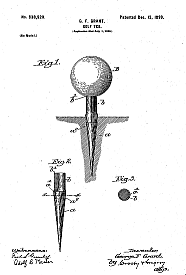GEORGE F. GRANT, OF BOSTON, MASSACHUSETTS.
GOLF-TEE.
SPECIFICATION forming part of Letters Patent No. 638,920, dated December 12, 1899.
Application filed July 1, 1899. Serial No. 722,500. (No model.)
To all whom it may concern:
Be it known that I, GEORGE F. GRANT, of Boston, county of Suffolk, State of Massachusetts, have invented an Improvement in Golf-Tees, of which the following description, in connection with the accompanying drawings, is a specification, like letters on the drawings representing like parts.
This invention has for its object the production of a simple, cheap, and effective tee for use in the game of golf, obviating the use of the usual conical mounds of sand or similar material formed by the fingers of the player on which the ball is supported when driving off. While the tee must firmly, yet lightly, support the ball until hit by the player's club, the tee must be so constructed that it will not in any manner interfere with the swing or "carry through" of the club in making the stroke. These requisites are possessed in full by my invention, and the annoyance and sometimes discomfort attendant upon the formation of a sand tee are obviated thereby.
Figure 1 represents a golf tee embodying one form of my invention, shown as inserted in the ground and supporting a ball ready to be struck. Fig. 2 is a side elevation of the base portion of the tee, the head being shown in section; and Fig. 3 is a transverse section on the line x x, Fig. 2.
In accordance with my invention the tee comprises a rigid base portion a and an attached flexible head b, the base being preferably made of wood and tapering to a point at its lower end to be readily inserted. in the ground. Near its upper end the base is preferably reduced in diameter, as at a', to leave an annular shoulder a², and over the reduced portion is stretched one end of a piece of rubber tubing forming the head b, the tubing being drawn down to the shoulder a². I prefer to cement the head to the base around the part a' of the latter, the open upper end of the head presenting an annular seat b', in which the ball B rests as in a cup, as shown in Fig. 1.
In practice the base is driven in to the ground to substantially the shoulder a², the head projecting upward about three-quarters of an inch. When the ball is struck, the head will yield in the direction of travel of the ball, offering no obstruction to its flight, and if the club strikes the head, as will frequently be the case, the yield will not in any way retard or stop the proper swing of the club as it is carried through the stroke.
The tee may be withdrawn after the drive and again used for the next drive, and so on, or the tee may remain permanently in the teeing-ground, as desired or found most, convenient.
By the use of the tee, as described, the player is sure that his ball is uniformly elevated from the ground at each drive and the uncertainty of a sand tee is overcome, as it is practically impossible to make them of uniform height each time.
Having fully described my invention, what I claim, and desire to secure by Letters Patent, is —
1. As an article of manufacture, a golf-tee comprising a tapering base portion to be driven into the ground point first, and a flexible tubular head, the lower end of which embraces the upper tapering portion of the base
2. As an article of manufacture, a golf-tee comprising a tapering base portion adapted to be inserted in the ground point first and having a shoulder near its upper end, a tubular head, the lower end of which embraces the tapering base portion above the shoulder.
In testimony whereof I have signed my name to this specification in the presence of two subscribing witnesses.
Witnesses:
JOHN C. EDWARDS,
EMMA J. BENNETT.





